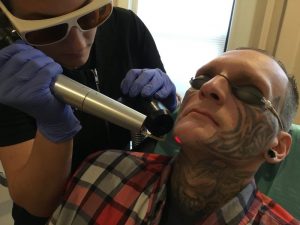 Shane MacLeod spent 14 years in federal prison for armed robbery and he’s covered from head-to-toe in tattoos. The only things not covered are his butt cheeks and the tops of his feet.
Shane MacLeod spent 14 years in federal prison for armed robbery and he’s covered from head-to-toe in tattoos. The only things not covered are his butt cheeks and the tops of his feet.
Inmates often tattoo one another with makeshift tools. Some get gang-related tattoos, which they consider a matter of survival. Others, such as 41-year-old MacLeod, are simply lured by the art.
“It’s kind of weird, because once you start getting tattoos, it’s like a tattoo fever thing,” MacLeod says. “Ya just keep gettin’ ’em, and gettin’ ’em, and gettin’ ’em, and the next thing ya know, you’ve got all this skin covered, and you’re like, oh my god, what the hell happened?”
But these days MacLeod notices people’s reactions to his tattoos: they’re either repelled or standoffish.
Tattoos can be a barrier for people getting out of prison. They can make it hard to find jobs, to feel safe in certain neighborhoods, to reconcile with family and to leave the past behind. Now there are programs to help inmates with tattoos wipe the slate clean.
Mark Drevno is executive director of the California-based nonprofit Jails to Jobs, which helps former prisoners find employment. He worries about their visible anti-social tattoos, such as swastikas, knives and profanity.
“Those types of tattoos are real job stoppers,” Drevno says.
So his organization has published a national directory of more than 300 free and low-cost tattoo removal programs for formerly incarcerated people. They’re in 42 states.
Drevno says the tattoo removal is essential to finding employment, housing, safety, family reconciliation and healing.
When MacLeod was released from prison two years ago, he had trouble finding work. The problem, his case manager said, was his face and neck tattoos – bold and intricate interlocking curves above fearsome gothic images.
In the upscale Boston office of The Finery, a tattoo-removal business with a special program to remove face, neck and hand tattoos of formerly incarcerated people free of charge, MacLeod reclines with his eyes protected by goggles.
To remove the tattoos, skilled technicians use laser machines to break up the ink particles, which the body then absorbs and flushes out. Sessions are six weeks apart, to allow the skin to heal in the interim. But the process is painful.
MacLeod says it’s like grease that jumps out of a bacon-frying pan and burns your arm. He dreads the pain, but he’s sticking with the program because he’s tired of being pre-judged.
There are his kids, including 6-month-old twins. The others are 6, 16 and 22.
MacLeod’s thinking about their weddings, and school functions with other parents. He wants to blend in.
Carmen Brodie, founder and CEO of The Finery, says of the 150 people who’ve started its special program, nearly 40 have completed it.
“Our biggest difficulty, and the biggest heartbreak in the whole thing, is that a lot of time we’ll let folks into the program, but they have a hard time finishing it, they have a hard time getting here on the day that they’re scheduled for,” Brodie says.
So Brodie’s in talks with Massachusetts’ maximum security prison to bring the program’s mobile unit out there. Tattoo removal before release, she says, would be a gamechanger.
If approved, Massachusetts would join a handful of state prisons with pre-release tattoo removal programs. California is about to expand its pre-release programs from two to 21 locations in the state. The goal is to offer the service to approximately 3,000 offenders per year.
